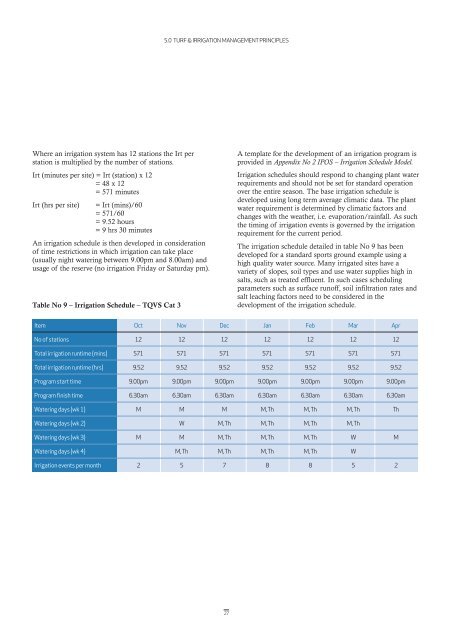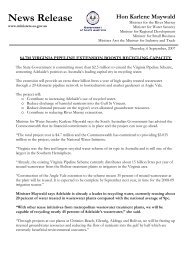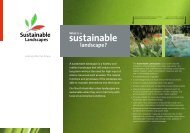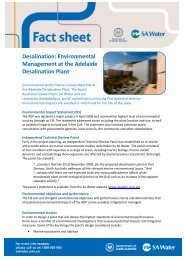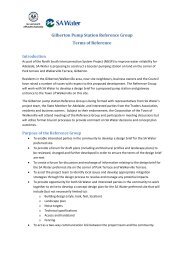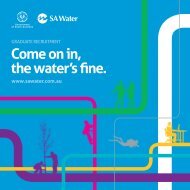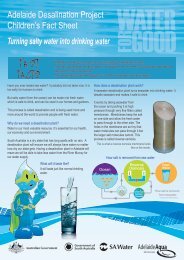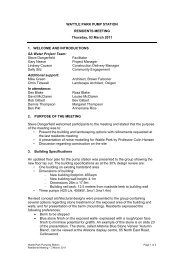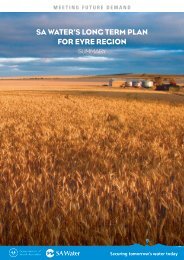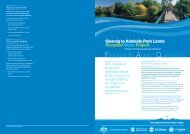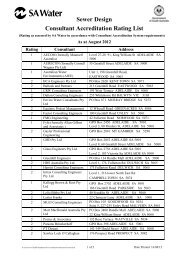Code of Practice - Irrigated Public Open Space - SA Water
Code of Practice - Irrigated Public Open Space - SA Water
Code of Practice - Irrigated Public Open Space - SA Water
You also want an ePaper? Increase the reach of your titles
YUMPU automatically turns print PDFs into web optimized ePapers that Google loves.
Where an irrigation system has 12 stations the Irt per<br />
station is multiplied by the number <strong>of</strong> stations.<br />
Irt (minutes per site) = Irt (station) x 12<br />
= 48 x 12<br />
= 571 minutes<br />
Irt (hrs per site) = Irt (mins)/60<br />
= 571/60<br />
= 9.52 hours<br />
= 9 hrs 30 minutes<br />
An irrigation schedule is then developed in consideration<br />
<strong>of</strong> time restrictions in which irrigation can take place<br />
(usually night watering between 9.00pm and 8.00am) and<br />
usage <strong>of</strong> the reserve (no irrigation Friday or Saturday pm).<br />
Table No 9 – Irrigation Schedule – TQVS Cat 3<br />
5.0 TURF & IRRIGATION MANAGEMENT PRINCIPLES<br />
27<br />
A template for the development <strong>of</strong> an irrigation program is<br />
provided in Appendix No 2 IPOS – Irrigation Schedule Model.<br />
Irrigation schedules should respond to changing plant water<br />
requirements and should not be set for standard operation<br />
over the entire season. The base irrigation schedule is<br />
developed using long term average climatic data. The plant<br />
water requirement is determined by climatic factors and<br />
changes with the weather, i.e. evaporation/rainfall. As such<br />
the timing <strong>of</strong> irrigation events is governed by the irrigation<br />
requirement for the current period.<br />
The irrigation schedule detailed in table No 9 has been<br />
developed for a standard sports ground example using a<br />
high quality water source. Many irrigated sites have a<br />
variety <strong>of</strong> slopes, soil types and use water supplies high in<br />
salts, such as treated effluent. In such cases scheduling<br />
parameters such as surface run<strong>of</strong>f, soil infiltration rates and<br />
salt leaching factors need to be considered in the<br />
development <strong>of</strong> the irrigation schedule.<br />
Item Oct Nov Dec Jan Feb Mar Apr<br />
No <strong>of</strong> stations 12 12 12 12 12 12 12<br />
Total irrigation runtime (mins) 571 571 571 571 571 571 571<br />
Total irrigation runtime (hrs) 9.52 9.52 9.52 9.52 9.52 9.52 9.52<br />
Program start time 9.00pm 9.00pm 9.00pm 9.00pm 9.00pm 9.00pm 9.00pm<br />
Program finish time 6.30am 6.30am 6.30am 6.30am 6.30am 6.30am 6.30am<br />
<strong>Water</strong>ing days (wk 1) M M M M,Th M,Th M,Th Th<br />
<strong>Water</strong>ing days (wk 2) W M,Th M,Th M,Th M,Th<br />
<strong>Water</strong>ing days (wk 3) M M M,Th M,Th M,Th W M<br />
<strong>Water</strong>ing days (wk 4) M,Th M,Th M,Th M,Th W<br />
Irrigation events per month 2 5 7 8 8 5 2


